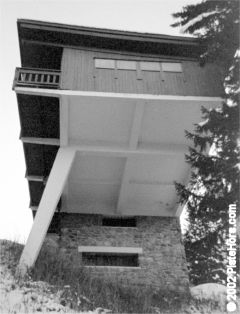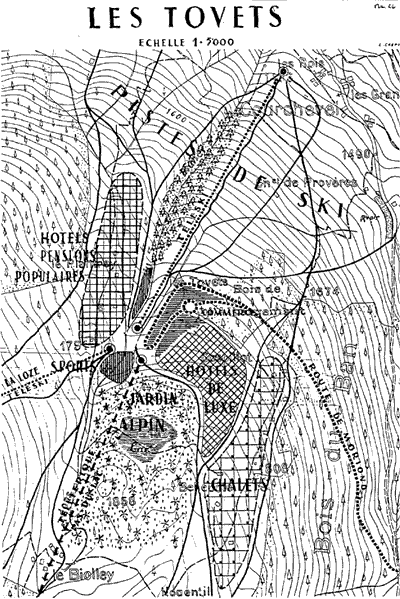
Ski-Areas > Northern Alps > Savoie (73) > Vanoise > Courchevel > History
French ski stations today fall broadly into three generations. Courchevel (and to a certain limited extent, Chamrousse in the Isère) is the unique example of the second generation where the state had a major role in constructing the resort. It fits between a traditional village like Megève and an integrated station constructed ex-nihilo such as la Plagne or Flaine. An incredible laboratory of ideas and experiments that would rarely been seen again in later developments more concerned with the bottom line.
Looking around the luxury palaces and swanky chalets it is hard to believe that Courchevel was originally conceived as the "People's Ski Resort" but scratch the faux-Savoyard surface you can still find traces of the post-war dreamers, such as the chalet built for the Industrialist Lang in 1950 and designed by the architect Denys Pradelle?. The story of Courchevel has its roots in the hardships of German occupation and the dreams to build a new kind of ski resort.

The Striking Chalet Lang
The Nazi invasion of France in 1940 had brought the nascent French Ski Industry to an abrupt halt. With many of the brightest engineers and planners languishing in prisoner of war camps there were neither the resources nor the manpower to spare on winter sports developments.
Before the outbreak of the war, Megève had been developed by the Rothschild family. A cable car, specifically to transport skiers, was built in 1933 but skiing really took off with the invention of the drag lift. The legendary Jean Pomagalski? installed the first lift on the Éclose slopes at l'Alpe d'Huez in 1935 and a lift was also built on the slopes of the Col de Porte near Grenoble in the same year. Due to the limits of transport at the time, skiing either developed around existing winter sports resorts such as Chamonix Mont Blanc, Megève, Le Mont Dore and Barèges or close to large towns like Grenoble. When Jacques Mouflier built a lift at the remote village of Val d'Isère nearly everyone, from the president of the French Ski Federation down, thought he was crazy.
Towards the end of the 1930s a search was started for a site suitable for a super station to rival those in Switzerland. The Tourist Commission encouraged the project. A number of proposals were developed. Le Corbusier at Vars in the Hautes Alpes, Chamrousse, the birthplace of French skiing in the Isère, and in the Trois-Vallées. However with the approach of war the political will was lacking. Only the privately financed project at les Allues (Méribel) in the Trois-Vallées, the personal project of Scotsman Peter Lindsay, saw lifts constructed in 1939.
In 1943, Laurent Chappis was a prisoner of war in Austria. He had just passed his diploma in architecture in captivity (l'université de captivité) and had started his thesis in town planning. A keen skier, before the war he had made some tours in the Allues and St Bon Valleys and had been impressed by the excellent skiing there. He decided to work on a project to improve the Three Valleys area of St Bon, Les Allues and les Bellevilles.
Despite the privations of the prisoner of war camp Chappis managed to lay his hands on a map in 1:50,000 scale of the area. His plan was to create three interconnected ski resorts. In the camp he was lucky to meet another Savoyard, Maurice Michaud?. It was Maurice Michaud who suggested to Chappis that he should find a rectilineal junction to connect the Three Valleys. Construction limits at the time meant that ski lifts could only travel in straight lines so this was the least expensive means of linking the areas. So it was that Chappis decided to start his series of ski lifts on the meadows of the Tovets in the valley of St Bon.

Denys Pradelle's Original Plan for Courchevel, May 1946
In 1942 the wartime Vichy government had not entirely lost interest in the idea of developing winter sports. Gérard Blachère, an engineer with the highways department, working for the Minister of Sports prepared a report on a super-station based in the Three Valleys area, to be built once the war was over. In 1945, after five years in a PoW camp, Michaud and Chappis returned to their beloved Savoie. Michaud was contacted by Pierre Cot?, a former minister with the Popular Front and now President of Finances for the Savoyard General Council. Cot wanted to improve the Savoie ski resorts and had asked Maurice Michaud to find people for the project. Chappis was the obvious candidate and Michaud gave him a copy of the Blachère report.
The attitude of the General Council was bold. Create a winter sports resort at the end of the war in the middle of reconstruction and make the department responsible for the project. Pierre de la Gontrie, a lawyer and president of the General Council and Cot, both men of the left managed to convince the council to start the project. For them, the modernisation of the Savoie was through tourism and tourism would bring pleasure and health to the young who had only known the struggles and shortages of war. Mr De la Gontrie explained his vision, "I think it will not only be the best station in France, but in Europe... normally the department and council has considerable expenditure but it is private enterprises who make the profits. But as it is the council enabling this major progress in the region it is only reasonable that it is the council reaps the rewards."
On the 26th of November 1945 the general council voted to build a ski resort with a strong social aspect where the department would have complete control over the terrain in order to stop any further speculation. A credit of 110 million (old) Francs was approved for the first phase. The project concerned the Three Valleys, but the British were already well established in the Allues and in Belleville the peasants were diametrically opposed to any outside interference (after the success of Courchevel they would develop les Menuires). That left St Bon, how would the St Bonnais react to the creation of a ski station from scratch?
Tourism was not completely unknown to the St Bonnais. The first hotel for the winter season opened in 1925. The young people in the area had already begun to learn to ski. Jean Blanc became French champion and had built the first teleski in 1946 on the Moriond. The mayor, Francis Mugnier sought to encourage these developments even if he didn't fully understand all that winter sports would bring to the populace. In a meeting in April 1946 in Chambèry he accepted Mr De la Gontrie proposition. He put his whole weight behind the effort to convince the peasants of St Bon to take a jump into the unknown and without precedent. Fifteen of the sixteen landowners were cooperative, only a lone farmer who owned a large property at Pralong refused to sell. So on the 3rd of May 1946 their land was transferred to the Department with the aim of building an access road and installing services and then reselling parcels of land to private investors who could develop to a fixed plan. An idea that preceded the concept of Societies d'Economie Mixte by 10 years. Around 202 hectares, almost all the land above 1800 meters was acquired, at 5 francs per m2 .
<< | Courchevel | The Battle of the Two Courchevels >>